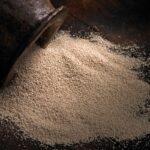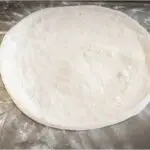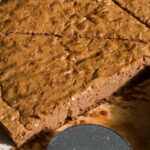Do you love bread and pizza? Are you always poised in the summer month to fire up your wood-fired pizza oven or get out your pizza stone for a super homemade pizza? If you love making pizza or artisan bread you may wonder what is the best dough to use. It’s easy to assume that both bread dough and pizza dough are pretty much the same things.
After all, they’re both doughs made from flour, water, and yeast, right? Well, not exactly. While they may share some similarities, there are some big differences between pizza dough and bread dough that makes each one unique. Let’s take a look at pizza dough vs bread dough.
How It’s Made?
Bread Dough
Bread dough typically is made from flour, water, yeast, and salt. It produces light and airy loaves of bread that have a traditional, uniform shape with a soft crumb and chewy crust. Bread dough is versatile and can be used in all kinds of recipes, from tasty bread to cinnamon rolls and artisanal sourdough loaves.
Pizza Dough
Basic pizza dough is also made from the same ingredients like flour, water, yeast, olive oil and salt. But the addition of olive oil makes it softer and more pliable than traditional bread dough. This gives pizza its characteristic stretch when being tossed in the air before baking—something unlike any other type of dough!
You can use pizza dough to create crispier crusts than regular breads, making it ideal for thin-crust pizzas as well as calzones, stromboli, cheese sticks and mini pizzas.
Texture
One of the biggest differences between pizza dough and bread dough is the texture. Pizza dough is usually much softer, stickier, and more elastic than bread dough. This is because pizza dough is made with a higher hydration level, meaning it has a higher percentage of water than bread dough.
Additionally, as we’ve mentioned, pizza dough often contains oil, which helps keep it from drying out and makes it even more elastic. Bread dough, on the other hand, tends to be much firmer and less elastic than pizza dough. This is because it’s made with a lower hydration level, meaning it has a lower percentage of water than pizza dough. Additionally, bread dough rarely contains oil, which makes it less flexible and more prone to drying out.
Rise
Another major difference between pizza dough and bread dough is the amount of rise they get. Pizza dough is typically made with active dry yeast, which causes it to rise quickly. This helps give pizza its unique, fluffy texture.
Bread dough, on the other hand, is often made with instant yeast, which causes it to rise more slowly. This helps keep bread dough from becoming too soft or sticky, and gives it a denser, chewy texture.
Flavor
The flavor of pizza dough and bread dough is also quite different. Pizza dough is usually made with a higher percentage of salt than bread dough, which helps give it a savory, salty flavor. Additionally, many pizza dough recipes call for the addition of herbs and spices, which can help give pizza its unique flavor. Bread dough, on the other hand, is usually made with less salt. This helps give bread its mild, slightly sweet flavor.
Many bread dough recipes call for the addition of ingredients like honey, butter, and other sweeteners, which can help give bread its unique flavor. Special bread such as sourdough bread artisan breads also contain unique flavors.
Time

The time it takes to make pizza dough and bread dough is also quite different. Pizza dough can be made in as little as 30 minutes, while bread dough can take up to several hours to make. This is because bread dough needs to rise for a longer period of time than pizza dough in order to develop its unique texture and flavor and be perfectly cooked.
Uses
The uses for pizza dough and bread dough are quite different, and bakers often wonder when to use bread dough and when to use pizza dough. If you want the perfect pizza crust use pizza dough.
By using a great bread dough recipe bread can be used for making yeasted loaves, dinner rolls, and other pastries; while pizza dough can be used to make pretty much anything you want—even some items that don’t include tomato sauce! One tip to remember is that you can use frozen bread dough thus cutting down on potential waste.
Flour
When it comes to choosing flour for your baked goods, all-purpose bread flour is a good choice if you do not need any extra flavor or structure from unbleached wheat flour or denser bread. For most baking applications, this will work well.
But for pizza crusts and other Italian dishes, many recipes call for “00” or “Flour Molino Raffinato,” which refers to finely ground flour made from hard wheat that helps give the pizza its light but tender texture and distinctive flavor. Unlike bread which requires kneading and gluing together, pizza doesn’t really require any special techniques before baking it up into delicious perfection!
When preparing your pizza, add salt & water – this combination isn’t strictly necessary as long as there are no flavor enhancers present like herbs/spices (which can sometimes provide too much moisture). All salt does is help activate enzymes responsible for developing flavor compounds – leaving behind something more pleasant tasting after baking.
Whether you are prepping dinner rolls or pizza pies — there’s no right or wrong answer in regard to determining what type of fermented grain products fit best into your recipe! Choose depending on what type of taste or style you’re aiming for —Or even your dietary needs. Both options offer quick prep times & delicious results, so why not experiment with both types instead of sticking to just one?
The Kneading Process
Kneading improves the texture of dough as well as flavor since it develops proteins (gluten) to create a stronger structure that also traps yeast better within its sheeting; this increased gas production leads to more volume in your baked goods!
To start kneading, fold one edge of the dough onto itself away from you before pushing down hard with the heel of both palms then turning it slightly towards you again before repeating these steps 9–10 times for each piece of dough (until it gathers itself into a smooth ball). Different recipes may call for slight variations in how long/intensely you should knead them – pizza crusts often require less time compared to regular breads – so adjust accordingly based on yours!
Conclusion
As you can see, there are some big differences between bread dough and pizza dough. While they may share some similarities, the texture, rise, flavor, time, and uses for each one are quite different. So the next time you’re making a deep-dish pizza or a loaf of bread, be sure to use the right dough for the job such as traditional pizza dough or basic bread dough. Or experiment with your favorite pizza dough recipe you never know what you may end up with.










